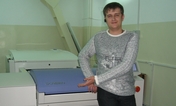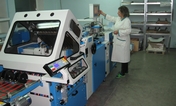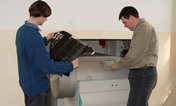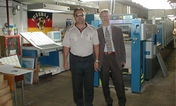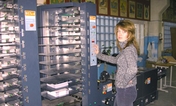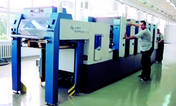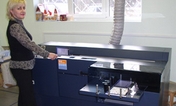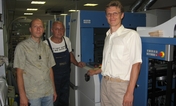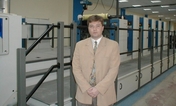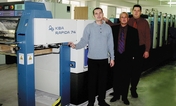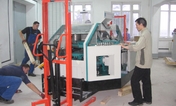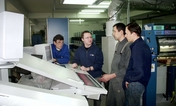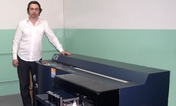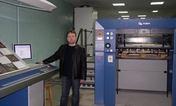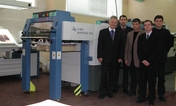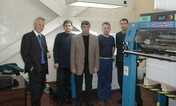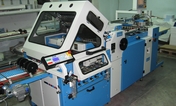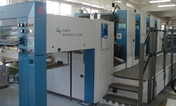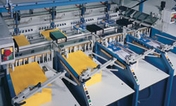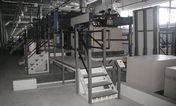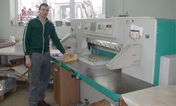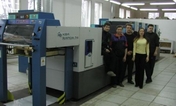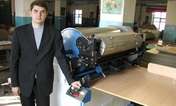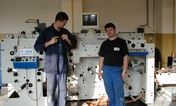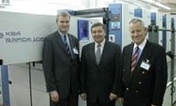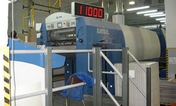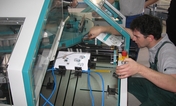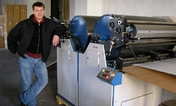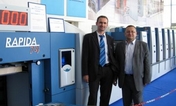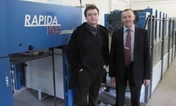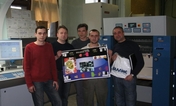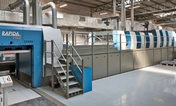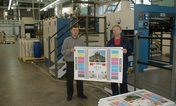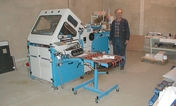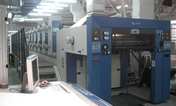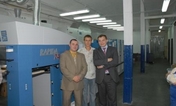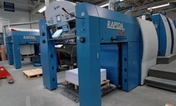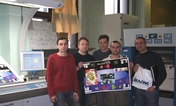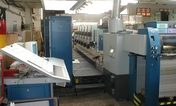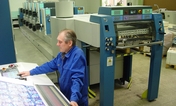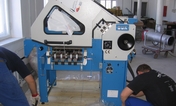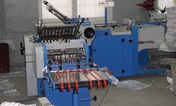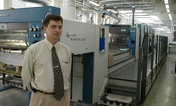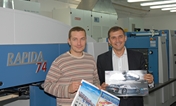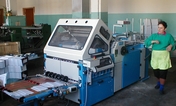
A press conference on 20 March, at the opening of a special sneak preview for invited users at the company's sheetfed offset facility in Radebeul, announced many of the Drupa highlights for offset and digital print to a wider audience for the first time. Around 1,000 print professionals from Europe and overseas took advantage of the open house to experience the latest sheetfed offset generation during impressive live demonstrations. With the unveiling of its new, highly automated large-format press series Rapida 145, represented on this occasion by a six-colour model tailored for packaging and an eight-colour perfector press for commercial and magazine printing, KBA underlined its technical supremacy as market leader in this format class. An example for meaningful synergy effects between offset and digital print was given with the new inkjet printing system for the new Rapida 105 medium-format generation. The Drupa curtain was naturally not yet raised on everything the engineers have up their sleeves in Radebeul, but the exciting innovations placed on the table so far have definitely justified the Drupa slogan “sprinting ahead”. KBA has booked a 3,500m2 (37,700ft2) stand in Dusseldorf (hall 16, stand 16C47) as the showcase for its many new and further developments for sheetfed, digital and web offset printers.
Bolza-Schunemann: print needs innovation
In his opening address, KBA president Claus Bolza-Schunemann drew attention to the tense market situation which still burdens the advertising- and media-dependent segments of the industry, and to the excess capacities which still exist in some areas on the manufacturer side, despite the painfully extensive workforce reductions. Years of unhealthy price competition were identified as a significant contributing factor in the recent bankruptcy of the former number-two German manufacturer. KBA, by contrast, has always rejected and continues to reject this path of problem solution on the shoulders of others. Through timely capacity downsizing at the group's own expense, intensification of the internal division of labour, an increased proportion of in-house production, development of the niche segments established over the past decades, and expansion into the field of digital print, the foundation has been laid for improved plant utilisation. KBA is the only one of the three major German manufacturers to have weathered recent storms by its own efforts, and was likewise the only press manufacturer to post a pre-tax profit in 2009, 2010 and 2011. The sums, however, are still insufficient to finance all the necessary investments and innovations, and so work continues on the optimisation of structures and processes, the broad and modern product portfolio, and the group sales organisation. Negotiations with a Chinese partner, for example, are already well advanced and envisage the local manufacturing of entry-level sheetfed offset presses for this enormous market, alongside the high-tech presses imported from Germany. Bolza-Schunemann emphasised that KBA would be maintaining its commitment to innovation, because an abandoning of technical progress would in his opinion worsen rather than solve the problems of the print branch in the online age.
Sprinting ahead: KBA active in shaping the future of print
Marketing director Klaus Schmidt explained that the slogan “sprinting ahead” also serves to spotlight the encouraging opportunities for print in the multimedia age. As an innovative press manufacturer, KBA intends to remain active in helping to shape the future of print. That was one of the reasons behind the group's move into digital print and the merging of digital inkjet technologies with analogue offset print. Despite the importance of thrift, the Drupa stand is the same size as in 2008, and the number of innovations on show has even been increased. The five sheetfed offset presses in small, half, medium and large format (three of which are completely new), three web offset installations for commercial, packaging and newspaper print (two of which are completely new) and the new inkjet web press from KBA will be complemented by a five-colour Rapida 106 coater for waterless UV offset and a Genius 52UV on the neighbouring stand of Japanese partner Toray Industries. The comprehensively equipped Rapida106 is configured for eco-friendly production on plastic films and other high-quality substrates.
KBA RotaJET 76: digital print from the offset experts
The round of Drupa innovation previews began with a high-volume web-fed inkjet press of the latest generation for the on-demand or individualised production of four-colour books, brochures, commercial products, mailings and magazines. The KBA RotaJET 76 built at KBA in W?rzburg was presented by new project manager Oliver Baar, an experienced specialist in the field of digital print. Engineered for a maximum web speed of 150mpm (493fpm) and web widths of up to 780mm (30.7in, corresponding to approx. 3,000 A4 pages/min or 85 million pages per month), the KBA RotaJET prints with water-based pigment inks. The state-of-the-art piezo inkjet heads are reliable in production and require only a minimum of maintenance. They have been designed for heavy-duty use and contribute to the high availability of the overall system. Frequent replacement is avoided and uninterrupted industrial production is guaranteed. Precision engineering from KBA is here the key to high print and register quality with the inkjet technology. This quality is only realised, however, in combination with precise web tension. The unwinder and infeed unit have thus been designed specifically for the RotaJET. Together with an ingeniously simple web lead without turning bars for four-colour production, they ensure excellent results. Web tension is controlled fully automatically. In this connection, Oliver Baar pointed out the greatly reduced waste compared to other press systems, as the RotaJET 76 is thus able to produce good copies even during the start-up phase. This permits considerably more efficient production and at the same time enhanced flexibility. An automatic reelstand with integration into automated paper logistics is to be made available in future as an option to further boost productivity. The web offset expertise is unmistakable.
The two arrays of 56 inkjet heads each (total 112) form an arch over large central impression cylinders for four-colour printing on both sides of the web, but can still be shifted aside for cleaning and maintenance purposes. This arrangement provides for optimum web guidance and facilitates an outstanding print quality even with problematic materials. The printing heads are cleaned and aligned automatically (stitching) to minimise manual intervention and ensure straightforward handling. The system offers a native print resolution is 600dpi, while the variable droplet size represents an additional quality plus. A dispersion coater is planned as a future option for further quality enhancement. Internal communication is compliant with the JDF standard, as is the integration with third-party systems – another feature which helps to optimise processes and lower costs. Drupa visitors will be able to witness personalised production driven through the popular Adobe APPE (Adobe PDF Print Engine) workflow. A powerful front-end is geared to the high data throughputs associated with industrial-scale PoD applications. With even the largest data volumes, the RotaJET 76 delivers full-colour variable production at maximum speed, without stoppage and waiting times. Another advantage, according to Oliver Baar, is that KBA speaks the language of generations of printers and understands the demands they place on systems, processes and final products.
The KBA RotaJET 76 on display at Drupa will be operating in conjunction with a SigmaLine digital production system from M?ller Martini, a solution for overall production control which has already been installed with numerous users worldwide. SigmaLine is here configured with the variable-format section folder module SigmaFolder and a Primera Digital saddle stitcher system, enabling digitally printed magazines and advertising brochures to be folded and stitched inline. SigmaLine is controlled through the smart data and process management system Connex, which ensures consistent integration between the printing press and the finishing equipment. Thanks to the modular system design and the broad spectrum of finishing options, SigmaLine can be tailored for both softcover and hardcover book production, as well as for a diversity of stitched products.
Turning to sheetfed offset users, the responsible head of marketing Jurgen Veil announced new press generations to be unveiled at the show, alongside ground-breaking technology innovations in all format classes.
New Rapida 145 defines new benchmarks for large format
As the established market leader, KBA has chosen Drupa as a fitting occasion to redefine the benchmarks for offset printing in large formats. The latest generation of large-format Rapidas is to celebrate its official market premiere in the form of a plinth-mounted six-colour Rapida 145 with new coater, triple-length extended delivery and automated pile logistics. The maximum production speed of the 1050 x 1450mm (41.34 x 57in) Rapida 145 is 17,000sph in straight printing with the high-speed package and 15,000sph in perfecting mode with the new three-drum perfecting unit. Many of the automation modules of the makeready world champion press Rapida 106 are now also available to large format users. The press to be seen at Drupa, for example, features the sidelay-free infeed DriveTronic SIS and DriveTronic SPC direct drives for fast, simultaneous plate changing. The CleanTronic Synchro system (two washing beams) for simultaneous washing of ink rollers, blankets and impression cylinders parallel to plate changing, a new programme for extremely fast inking unit washing (CleanTronic ReInk) and further parallel makeready processes contribute to significantly higher net production output compared to the predecessor series and presses from other manufacturers. The same can be said of the new coater with simultaneous coating forme changing (DriveTronic SFC) and of the fast, one-man replacement of the exchangeable anilox roller sleeves (AniSleeve). The high production speed of 17,000sph is made possible not least by the new AirTronic delivery with high-level Venturi sheet guiding, dynamic sheet brake and console-based preset capabilities, and by a new blade chamber for the coating system (HighFlow Chamber). Convenient operation is guaranteed at the new ErgoTronic console with wall screen, picture-in-picture function and integrated colour measurement and control system (QualiTronic ColorControl) for quality monitoring. In addition, the new large-format Rapida presses feature inline register control (QualiTronic ICR), and with QualiTronic PDF it is possible to perform an inline comparison between the print result and the original PDF file. The energy-saving KBA VariDryBLUE dryers which were already offered to large format users are to be made available also for medium-format presses in the future.
Digital joins offset: Rapida 105 with inkjet printing system
With the Rapida 105, KBA will also be presenting a completely new medium-format series in Dusseldorf. The press was unveiled to the public at the All in Print China fair in Shanghai last November. The high-level delivery is immediate indication that the new Rapida 105 is based on the same platform as the high-end Rapida 106 press. The range of automation options has been extended compared to the predecessor model. After positive experience with the presses delivered over the past three months, the maximum production speed for presses incorporating the high-speed package is to be raised to 17,000sph (standard: 16,500sph) with effect from Drupa. The Rapida 105 is now also available in a four-back-four perfector configuration, with a perfecting unit based on the modern technology of the Rapida 106. The new Rapida 105 thus packs all the features expected of a modern commercial press placed under the banner: “Designed for Performance”.
The real show highlight, however, is the presentation of this internationally popular press type in a hybrid offset/inkjet version. The five offset printing units and coater tower are joined by an inkjet unit with two Delta 105iUV printing systems from Atlantic Zeiser for personalised imprinting and coding applications. Thanks to an innovative vacuum cylinder (AirTronic Drum) to fix the sheets under the inkjet heads, the KBA Rapidas (105 and 106) are currently the only presses on the market to realise this option without the need for mechanical sheet guides and print-free corridors. The unique solution prevents lifting of the tail edges and enables the inkjet systems to be installed at a clearance of only 1mm (0.04in) from the sheet. UV-LED dryers provide for fast drying of the ink.
There are many potential applications for inkjet systems in a sheetfed printing press. They range from sheet marking in connection with quality inspection using the alphaJET-tempo printer from KBA-Metronic to codings for purposes of brand protection (barcodes, QR codes, numerical IDs or combinations thereof). Relevant fields are security printing, packaging, labels, lottery tickets and industrial product marking. Up to eight inkjet heads from Atlantic Zeiser can be accommodated in a printing unit of the Rapida 105 or 106 press. The high-speed greyscale printer is equally suitable for coated, laminated, glossy and non-absorbent materials. A mini controller takes care of system handling in marking, inspection and quality assurance processes. Quality control, including verification of the variable data, is similarly the purpose of a high-speed camera system. Another interesting option for packaging printers is the marking of individual blanks in connection with the inline sheet inspection system KBA QualiTronic MarkPlus. Flawed blanks can then be ejected automatically during downstream processing, e.g. in the folder gluer. With the KBA AirTronic Drum, further inline finishing processes are likely to be integrated in future.
Rapida 106: 20,000sph and duplex inline coating
The makeready world champion press Rapida 106 was first presented at the last Drupa in 2008. For this year's show, an optional package now raises the maximum production speed one notch further to 20,000sph in straight printing and 18,000sph in perfecting mode. The KBA flagship in medium format is to be seen in a 12-unit configuration for four-colour print and inline coating on both sides of the sheet. Among the many innovations incorporated into this already highly automated press, particular mention should be made of the new coater tower with simultaneous forme changing (DriveTronic SFC), automated anilox roller exchange with AniloxLoader, the further optimised AirTronic delivery for exact pile formation at even the highest speeds, new modules for online and inline quality monitoring and control, and a new ErgoTronic console with wall screen as on the large-format presses.
B2 format: high-end Rapida 76 to complement the Rapida 75
In the half-format segment, the 15,000sph, 530 x 750mm (20.86 x 29.53in) Rapida 75E unveiled at Ipex 2010 has been upgraded in terms of sheet travel, feeder, delivery and many other technical details. It is now offered with the new ErgoTronic console, QualiTronic inline colour measurement and control system and a UV accessory package, and is now available in a four-back-four perfector version. The compact, energy-saving B2-format press has regained its original name of Rapida 75 and will be joined at Drupa 2012 by a sister press boasting higher speed and an enhanced level of automation: the high-end Rapida 76.
The new Rapida 76 on the stand in Dusseldorf is a five-colour coater press. With its maximum speed of 18,000sph in straight printing, it is an interesting proposition for both commercial and packaging printers and incorporates many of the automation options of its medium-format sister Rapida 106. These include DriveTronic SIS sidelay-free infeed, fast automatic plate changers, DriveTronic SPC dedicated drives for the plate cylinders, fast, simultaneous washing with CleanTronic Synchro and ErgoTronic online colour measurement and control at the new console, or inline colour measurement and control with QualiTronic. With the Rapida 76, KBA has transferred cutting-edge solutions from its large and medium-format presses into the half-format class.
Innovation in web offset, too: C16 and Commander CL
In commercial and newspaper web offset, too, KBA is able to present a raft of new developments addressing the latest market demands. The Commander CL, the newspaper press with module-based automation launched at IFRA Expo in Vienna in October 2011, for example, is to be shown for the first time with a compact printing unit featuring semi- and fully automatic plate changing and further innovations, alongside the very latest ErgoTronic console technology. In addition, a printing unit of the 16-page commercial press KBA C16 will be spotlighting the further optimisation for fast job changes with short and medium runs, together with its new low-maintenance quarterfold module and user-oriented console.
KBA-MePrint: variable-format Varius for flexible packaging
Subsidiary KBA-MePrint has prepared two presses of the small-format Genius 52UV series with a number of new features which are to be available in the future (envelope feeder; rainbow printing). Another highlight is an interesting new development for the growth market of flexible packaging. The new Varius 80 is a modular, variable-format web offset press. It implements the same waterless technology as the Genius, with short-train inking units and UV drying. This combination achieves excellent print quality on flexible, non-absorbent substrates with very low start-up waste. The offset plates, moreover, are significantly less expensive than the sleeves required for a flexo process. The keyless and waterless Varius 80 is already in full colour after 100 metres – a waste saving of around 80% compared to other presses. As runs become ever shorter and job changes more frequent, that is an advantage which can make all the difference. And the higher quality of offset compared to flexo no doubt answers the wishes of many print customers. The environment also benefits, because the Varius 80 uses no water, no solvent and no powder. Engineered for a maximum web width of 800mm (31.5in) and a production speed of 400 metres per minute (1,312fpm), the Varius 80 from KBA-MePrint handles substrate thicknesses from 30 to 800µm. The printing length is variable between 21 and 34 inches. Changes in format length are accomplished in a matter of minutes with an automated plate and blanket cylinder change function (no sleeves).
KBA-Metronic: innovative marking with betaJET
As a specialist for digital and analogue marking and coding systems, KBA-Metronic will be showcasing yet another interesting solution for the packaging branch. The betaJET thermal inkjet unit integrated into the udaFORMAXX feeding system for sleeves, cartons and the like is freely programmable. As such it is suitable for a diversity of uses, for example in addressing applications, as an anti-counterfeiting module in the pharmaceuticals industry, for brand protection or in just-in-time manufacturing in the textiles and cosmetics branches.
Green printing, technology lounge, JDF workflow, MIS etc
As a declared pioneer of eco-friendly production, as already demonstrated at Drupa 2008, KBA will again be lending particular weight to the topic of “green printing”. Four web and sheetfed presses implement a waterless UV process. New offers for climate-neutral print and the possibilities for climate-neutral press manufacture are to be presented in cooperation with Climate Partner. And in a dedicated technology lounge, KBA will be putting forward current and future solutions for UV-LED and HR-UV drying, energy management and heat recovery in the printshop. The CtP pre-press with a Magnus 800 MCU platesetter is from Kodak, as at previous Drupas. The JDF workflow on the stand is networked via KBA LogoTronic Professional, and Italian KBA partner Logica Sistemi will be presenting branch-specific MIS software suitable also for smaller users.

